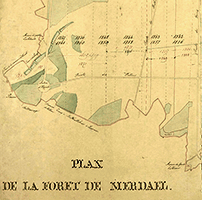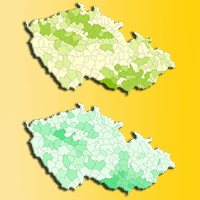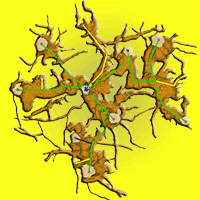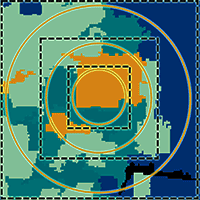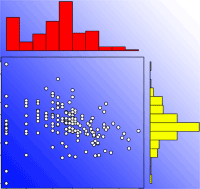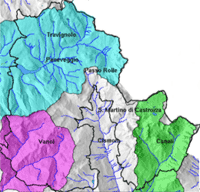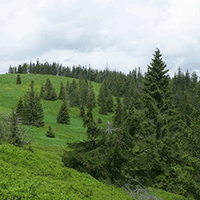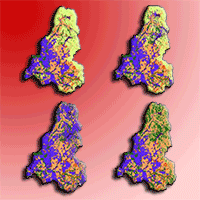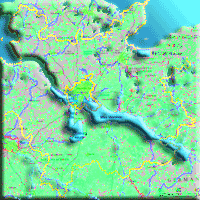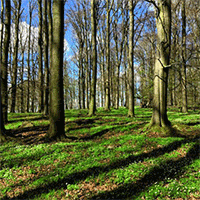
A multisource approach helps to detect a forest as a reference site in an intensively used rural landscape (Uckermark, NE Germany)
Monika Wulf (1) , Knut Kaiser (2), Almut Mrotzek (3), Lina Geiges-Erzgräber (4), Lars Schulz (5), Irina Stockmann (6), Thomas Schneider (7), Christoph Kappler (2), Oliver Bens (2)
iForest - Biogeosciences and Forestry, Volume 14, Issue 5, Pages 426-436 (2021)
doi: https://doi.org/10.3832/ifor3774-014
Published: Sep 21, 2021 - Copyright © 2021 SISEF
Research Articles
Abstract
The sharp decline in seminatural areas worldwide is undisputed, but the consequences of this decline, apart from the loss of biodiversity, cannot be fully assessed. To restore ecosystems or landscapes, it is essential to have so-called reference sites. We want to show how reliable reference sites can be found in heavily used landscapes with the help of independent sources, and we present an approach that can be used in other regions, because it is very well suited for developing essential databases in the context of theses at different levels. A forest of seminatural stocking was selected in northeast Germany as a case study. The mapping of archival sources and the analyses of historical maps as well as field investigations were combined to reconstruct the dynamics of vegetation and soil for the last several centuries to thousands of years. Palynological data from nearby sites show that the study area has been forested for several millennia and has been less influenced by humans in the last 450 years. Together with historical maps of tree species composition, it allows to infer that the specific forest has been preserved in good ecological conditions for at least 250 years. Soil inventory and field studies on two catenas and corings support this conclusion, as they rarely show signs of anthropogenic erosion and related colluviation. Using a multisource approach, it is possible to identify potential reference sites that provide a reliable basis for ecosystem or landscape restoration.
Keywords
Ancient Forest, Geo-bio-archives, Historic Maps, Land Use Legacy, Pollen Analysis, Reference Site
Authors’ Info
Authors’ address
Research Area 2 - Land Use and Governance, Leibniz Centre for Agricultural Landscape Research - ZALF, Müncheberg (Germany)
Christoph Kappler 0000-0001-9099-1546
Oliver Bens 0000-0003-3872-0081
GFZ German Research Centre for Geosciences, Potsdam (Germany)
Institute of Botany and Landscape Ecology, University of Greifswald, Partner in the Greifswald Mire Centre, Greifswald (Germany)
Institute for Geographical Science, Free University of Berlin, Berlin (Germany)
Institute for Ecology, Technical University of Berlin, Berlin (Germany)
Institute of Earth and Environmental Science, University of Potsdam, Potsdam-Golm (Germany)
Faculty of Landscape Management and Nature Conservation, Eberswalde University for Sustainable Development, Eberswalde (Germany)
Corresponding author
Paper Info
Citation
Wulf M, Kaiser K, Mrotzek A, Geiges-Erzgräber L, Schulz L, Stockmann I, Schneider T, Kappler C, Bens O (2021). A multisource approach helps to detect a forest as a reference site in an intensively used rural landscape (Uckermark, NE Germany). iForest 14: 426-436. - doi: 10.3832/ifor3774-014
Academic Editor
Emilia Allevato
Paper history
Received: Feb 05, 2021
Accepted: Jul 18, 2021
First online: Sep 21, 2021
Publication Date: Oct 31, 2021
Publication Time: 2.17 months
Copyright Information
© SISEF - The Italian Society of Silviculture and Forest Ecology 2021
Open Access
This article is distributed under the terms of the Creative Commons Attribution-Non Commercial 4.0 International (https://creativecommons.org/licenses/by-nc/4.0/), which permits unrestricted use, distribution, and reproduction in any medium, provided you give appropriate credit to the original author(s) and the source, provide a link to the Creative Commons license, and indicate if changes were made.
Web Metrics
Breakdown by View Type
Article Usage
Total Article Views: 31267
(from publication date up to now)
Breakdown by View Type
HTML Page Views: 26457
Abstract Page Views: 2324
PDF Downloads: 1864
Citation/Reference Downloads: 5
XML Downloads: 617
Web Metrics
Days since publication: 1553
Overall contacts: 31267
Avg. contacts per week: 140.93
Citation Metrics
Article Citations
Article citations are based on data periodically collected from the Clarivate Web of Science web site
(last update: Mar 2025)
Total number of cites (since 2021): 1
Average cites per year: 0.20
Publication Metrics
by Dimensions ©
Articles citing this article
List of the papers citing this article based on CrossRef Cited-by.
References
Bodenkundliche Kartieranleitung [Soil mapping instructions]. Schweizerbart, Hannover, Germany, pp. 438. [in German]
Gscholar
Beiträge zum militärischen Vermessungs- und Kartenwesen und zur Militärgeographie in Preußen (1803-1921) [Contributions to military surveying and mapping and to military geography in Prussia]. Schriftenreihe Geoinformationsdienst der Bundeswehr 1: 1-200. [in German]
Gscholar
Die Uckermark: Geschichte einer kurmärkischen Landschaft vom 12. bis zum 18. Jahrhundert [The Uckermark: history of a Kurmärkian landscape from the 12th to the 18th century]. Böhlau, Weimar, Germany, pp. 730. [in German]
Gscholar
Historisches Ortslexikon für Brandenburg. Teil VIII. Uckermark [Historical encyclopaedia of places in Brandenburg. Part VIII. Uckermark]. Klaus-D Becker, Potsdam, Germany, pp. 1284. [in German]
Gscholar
Textbook of pollen analysis (4th edn). John Wiley and Sons, Chichester, UK, pp. 328.
Gscholar
Glashütten in Brandenburg [Glassworks in Brandenburg]. Heimatkundliche Beiträge 1: 1-64. [in German]
Gscholar
Der Baumartenwandel der Fürstenwerderschen Heide von 1780 bis 2010 [The change in tree species on Fürstenwerder Heath from 1780 to 2010]. Bachelor’s thesis, Free University of Berlin, Germany, pp. 77. [in German]
Gscholar
Klima [Climate]. In: “Physische Geographie Deutschlands” [Physical Geography of Germany] (Liedtke H, Marcinek J eds). Perthes, Gotha, Germany, pp. 23- 119. [in German]
Gscholar
Anwendungsmöglichkeiten digitaler historischer Karten in der forstlichen Waldentwicklungsplanung Brandenburgs [Possible applications of digital historical maps in forest development planning in Brandenburg]. Vermessung Brandenburg 1: 22-30. [in German]
Gscholar
Die Potentielle Natürliche Vegetation von Brandenburg und Berlin mit Karte M 1:200.000 [The potential natural vegetation of Brandenburg and Berlin with map M 1:200.000]. Eberswalder Forstliche Schriftenreihe 14: 1-315. [in German]
Gscholar
Die holozäne Waldgeschichte von Brandenburg und Berlin - eine aktuelle Übersicht [The Holocene forest history of Brandenburg and Berlin - a current overview]. Tuexenia Beiheft 4: 47-55. [in German]
Gscholar
Palaeosols and their cover sediments of a glacial landscape in northern central Europe: spatial distribution, pedostratigraphy and evidence on landscape evolution. Catena 193: 104647.
CrossRef | Gscholar
Slawen und Deutsche in der Uckermark. Vergleichende Untersuchungen zur Siedlungsentwicklung vom 11. bis zum 14. Jahrhundert [Slavs and Germans in the Uckermark. Comparative studies on settlement development from the 11th to the 14th century]. Franz Steiner, Stuttgart, Germany, pp. 546. [in German]
Gscholar
Die amtlichen topographischen Kartenwerke der Bundesrepublik Deutschland [The official topographic map series of the Federal Republic of Germany]. Sammlung Wichmann 10: 1-51. [in German]
Gscholar
Charakterisierung der Böden Brandenburgs hinsichtlich ihrer Verbreitung, Eigenschaften und Potenziale mit einer Präsentation gemittelter analytischer Untersuchungsergebnisse einschließlich von Hintergrundwerten (Korngrößen-zusammensetzung, Bodenphysik, Bodenchemie) [Characterisation of the soils of Brandenburg with regard to their distribution, properties and potentials with a presentation of averaged analytical investigation results including background values (grain size composition, soil physics, soil chemistry)]. Brandenburger Geowissenschaftliche Beiträge 22: 5-135. [in German]
Gscholar
Neolithikum im Odergebiet. In: “Forschungen zu Mensch und Umwelt im Odergebiet in ur- und frühgeschichtlicher Zeit” (Gringmuth-Dallmer E, Leciejewicz L eds). Phillip von Zabern, Mainz, Germany, pp. 257-263. [in German]
Gscholar
Forstliche Standortkartierung Stand 2009, redigiert 2013. Information online “Forstliche Standortskarte des Landes Brandenburg: Linien der Stamminformationen (LS)” [Forest site mapping as of 2009, edited in 2013. Information online "Forest site map of the state of Brandenburg: lines of stem information (LS)]. Landesbetrieb Forst Brandenburg - LFB, Web site. [in German]
Online | Gscholar
Geologische Übersichtskarte des Landes Brandenburg 1:300.000 [Geological outline map of the state of Brandenburg 1:300.000]. Landesamt für Geowissenschaften und Rohstoffe Brandenburg, Potsdam, Germany, pp. 70. [in German]
Gscholar
Hemerobiegrad und Seltenheit als Bewertungskriterien von Böden dargestellt an Bodencatenen [Degree of hemeroby and rarity as evaluation criteria of soils illustrated by soil catena]. Geowissenschaftliche Mitteilungen von Thüringen Beiheft 10: 53-61. [in German]
Gscholar
Flächendeckende Biotop- und Landnutzungskartierung im Land Brandenburg (BTLN), “CIR-Biotoptypen 2009”, Kartiereinheiten [Area-wide biotope and land use mapping in the state of Brandenburg (BTLN), “CIR biotope types 2009”, mapping units]. Landesamt für Umwelt, Gesundheit und Verbraucherschutz Brandenburg - LUGV, Potsdam, Germany, pp. 89.
Gscholar
Ein Buchenwald im Wandel der Zeiten - 300 Jahre Nutzungsgeschichte im Grumsiner Forst [A beech forest through the ages - 300 years of use in Grumsin Forest]. Natur und Text, Rangsdorf, Germany, pp. 103. [in German]
Gscholar
Pollen Analysis (2nd edn). Blackwell, Oxford, UK, pp. 216.
Gscholar
The determination of ecological status in shallow lakes: a tested system (ECOFRAME) for implementation of the European Water Framework Directive. Aquatic Conservation: Marine and Freshwater Ecosystems 13: 507-549.
CrossRef | Gscholar
Die “Heiligen Hallen” in den vergangenen 1000 Jahren [The “Holy Halls” over the past 1000 years]. Labus - Naturschutz in der Region Mecklenburg-Strelitz Sonderheft 20: 48-55. [in German]
Gscholar
Datenspeicher Wald, Version 2 [Data Storage Forest, version 2]. AFZ/Der Wald 13: 10-11. [in German]
Gscholar
Protection gaps and restoration opportunities for primary forests in Europe. Diversity and Distribution 26: 1646-1662.
CrossRef | Gscholar
Historischer Landnutzungswandel im Quillow-Einzugsgebiet in der Uckermark (Brandenburg) unter besonderer Berücksichtigung der Gemarkung Christianenhof und Umgebung [Historical land use change in the Quillow catchment area in the Uckermark (Brandenburg) with special reference to the Christianenhof district and surrounding area]. Bachelor’s thesis, University for Sustainable Development, Eberswalde, Germany. [in German]
Gscholar
Ur- und frühgeschichtliche Besiedlung [Prehistoric and early historic settlement]. Werte der deutschen Heimat 57: 16-19. [in German]
Gscholar
Böden und ihr landschaftsgeschichtliches Potenzial in einem “Altwald” (NSG Kiecker, Kreis Uckermark/Brandenburg) [Soils and their landscape-historical potential in an “old-growth forest” (NSG Kiecker, district of Uckermark/Brandenburg)]. Bachelor’s thesis, Technical University of Berlin, Germany, pp. 58. [in German]
Gscholar
Ur- und Frühgeschichte des Prenzlauer Raumes: von den Anfängen der menschlichen Besiedlung bis zu den Anfängen der Stadt im 13. Jahrhundert [Prehistory and early history of the Prenzlau area: from the beginnings of human settlement to the beginnings of the town in the 13th century]. In: “Geschichte der Stadt Prenzlau” (Neitmann K, Schich W eds). Geiger, Horb am Neckar, Germany, pp. 15-26. [in German]
Gscholar
Anleitung für die forstliche Standorterkundung im nordostdeutschen Tiefland - (Standortserkundungsanleitung) SEA 95, Bd. A - Standortsform [Instructions for Forest Site Investigation in the North-East German Lowlands - (Site Investigation Instructions) SEA 95, Vol. A - Site Form]. Self-Publisher, Ministerium für Landwirtschaft und Naturschutz des Landes Mecklenburg-Vorpommern, Schwerin, Germany, pp. 298. [in German]
Gscholar
GIS-gestützte Rekonstruktion der Waldentwicklung im NSG “Kiecker” (Landkreis Uckermark) seit Mitte des 18. Jahrhunderts [GIS-supported reconstruction of forest development in the NSG "Kiecker" (district of Uckermark) since the middle of the 18th century]. Bachelor’s thesis, University of Potsdam, Germany, pp. 84. [in German]
Gscholar
Late Weichselian landscape development and human settlement in Mecklenburg-Vorpommern (NE Germany). Eiszeitalter und Gegenwart 54: 138-175.
Gscholar
Glashütten in Mecklenburg [Glassworks in Mecklenburg]. Darstellung eines Gewerbezweiges. Schriftenreihe des Karbe-Wagner-Archivs 15: 1-56. [in German]
Gscholar

